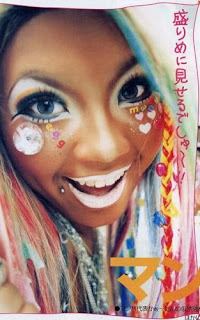Featured
- Get link
- X
- Other Apps
Purikura Madness
 |
| Purikura Photo Booth |
 |
| Purikura Photos |
After the beautification session is over,
participants leave the booth and wait at the screen outside the booth to print
their photos. There are 3 options to choose from: additional copies, the choice
of printing photos in extra large format or sending photos to mobile phones
(which of course was added later when mobile phones became widely used).
Later, such photos are stored in special
Purikura albums, which the girls carry with them practically all the time so
that they can exchange photos with friends or simply view each other's albums
(2).
I hope you liked the article, if so like it, leave a comment or share. I always like to hear different opinions and will be happy to respond to any comment. Until next time 😊
References:
(1) Harvard Asia Quarterly,
2003. Harvard Asia Quarterly. A Journal of Asian Studies Affiliated
with the Harvard University Asia Center, [online] VII(3), p.32. Available
at:<https://projects.iq.harvard.edu/files/har/files/vol_7.3_summer_2003.pdf>
[Accessed 23 March 2021].
(2) Okabe,
D., Ito, M., Chipchase, J. & Shimizu, A., 2006. The Social Uses of
Purikura: Photographing, Modding, Archiving, and Sharing.
W moim
poprzednim poście, który znajdziecie tu < Pen Pal Friends, Postcards and Japan>
wspomniałam o malutkich, słodkich przylepianych zdjęciach, które dostawałam
zazwyczaj w listach od moich Pen Friends. Zdjęcia te nazywane są w Japonii
„Purikura”. Nazwa Purikura wywodzi się od angielskiej nazwy „Print Club”,
wymawianej przez Japończykow „Purinto Kurabu” i stąd jej skrócona nazwa. Zdjęcia
– naklejki były (i nadal są) sprzedawane ze specjalnych budek ze zdjęciami, coś
na kształt dzisiejszych budek ze zdjęciami do paszportu. Owe budki z Purikura
były zazwyczaj umiejscowione w centrach gier, galeriach handlowych czy stacjach
kolejowych a ich twórcą była firma zajmująca się tworzeniem softwaru o nazwie
Altus z siedzibą w Tokyo. Wszystko zaczęło się w momencie kiedy pracowniczka
tej firmy Sasaki Miho postanowiła wykorzystać niesamowity szał na naklejki
wśród uczennic, który generował pokaźne zyski w latach 90-tych. Szał na
naklejki o różnej tematyce czy to postaci z ulubionych seriali anime czy słodkich
zwierzątek był na tyle wielki że naklejki były kupowane w arkuszach i używane
do ozdabiania albumów z wycinkami, listów czy albumów na zdjęcia. Naklejki te
można było również kolekcjonować i w tym celu stworzono nawet specjalne mini albumy
do ich przechowywania, które były na tyle małe, że można je było przyczepić do
breloczków od kluczy, torebki czy plecaka i pokazać je przyjaciołom. W 1994 r.
Sasaki wpadła na pomysł aby połączyć te dwa pomysły w jedno ale musiał minąć
jeszcze rok zanim jej pomysłowi dano szansę. W 1995r. firma Altus opracowała
specjalną maszynę która tworzyła ekspresowe, łatwo edytowalne zdjęcia które
stały się natychmiastowym hitem i do 1996r. zyski ze sprzedaży z tych maszyn wygenerowaly
70% z 36.5 miliarda jenow (1).
No ale
jak to wszystko działa? Wszystko dzieje się za magiczną kurtyną ;D Cała budka
jest dość duża, mieści od 4-8 osob jednocześnie. Koszt takiej sesji wynosi 400
jenow i zaraz po uiszczeniu tej opłaty do dyspozycji jest duży ekran dotykowy,
na którym można wybrać tła, jasność i inne funkcje niestandardowe. Minutnik na
wyświetlaczu odlicza czas pomiędzy każdym ujęciem, gdzie pojawiać się będą różne
tła, a uczestnicy będą zmieniać pozy czy robić smieszne miny. Po sesji
fotograficznej uczestnicy opuszczą obszar studia i przeniosą się do „kącika
graffiti” gdzie będą mieli możliwość edytowania swoich zdjęć używając do tego
przeznaczonych specjalych dlugopisów zwisających z boku ekranu dotykowego. Po
rozpoczęciu sesji zaczyna się ponowne odliczanie czasu pozostałego na edycję i
zależy on od ilości osob czekającyh na wykonanie zdjęć lub przebywających w „kącikach
graffiti”.
Po zakończeniu
sesji upiękrzającej uczestnicy opuszczają budkę i czekają przy ekranie na zewnątrz na wydrukowanie zdjęć. Do wyboru są 3 opcje: dodatkowe kopie, wybór wydrukowania zdjęć w extra dużym formacie albo wysłanie zdjęć do telefonow komórkowych (co oczywiście było dodane w późniejszym okresie kiedy to telefony komórkowe zaczęły być powszechnie używane).
Później
zdjęcia takie są przechowywane w specjalnych albumach Purikura, które dziewczeęta
nosza ze sobą praktycznie przez cały czas aby można było się wymienić zdjęciami
z przyjaciółmi czy po prostu pooglądac nawzajem swoje albumy (2).
Wracając
pamięcią do tamtych czasów, nie mogłam wyjść z podziwu nad Purikurą. W latach
90-tych w Polsce dostępne były tylko cyfrowe aparaty fotograficzne, z których
zdjęcia zapisywane były na specjalnej kliszy fotograficznej. Wywoływanie
takiego zdjęcia robione było na zamówienie, w ciemni fotograficznej. Dostępne
też były Polaroidy, ktore natychmiastowo drukowaly zdjęcia tuż po ich
zrobieniu. Natomiast opcja edycji jakiekogolwiek zdjęcia była nie możliwa. Te
zdjęcia Purikura przylepione na listach od Chigusy były dla mnie czyms
niesamowitym, jakby nie z tej ziemi. Zawsze bardzo mi imponowało, że Japonia
jest tak bardzo rozwinięta technologicznie i kulturowo. Gdy odwiedzę Japonię
wykonanie Purikury jest na szczycie mojej listy do zrobienia 😊.
Mam
nadzieję, że podobał wam się artykuł, a jeśli tak to polub, zostaw komentarz
lub udostępnij. Zawsze lubię poznawać różne opinie i chętnie odpowiem na każdy
komentarz. Do usłyszenia 😊
- Get link
- X
- Other Apps
Popular Posts
Ganguro – Japanese girls - forgotten subculture
- Get link
- X
- Other Apps



Comments
Post a Comment